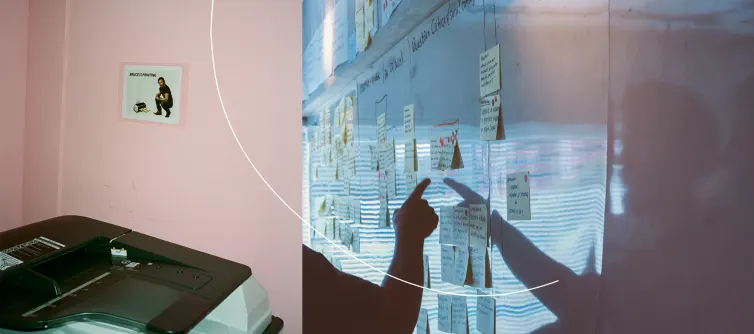Welcome to part 3 of the Typeform v2 rollout story. In this three-part series, we rip down the curtain on the revamp and release of the new Typeform.
Part 1: Inside Typeform version 2
Part 3: Rallying the entire company to launch the new Typeform
Spend time in any office and you’ll find yourself asking the same questions: How does the printer work? Who do I talk to about my doctor’s appointment? Who’s the office’s top FIFA player, and can that be proven empirically and unequivocally?
This is where we are today.
Four years ago, the first version of Typeform was born. Today, we grow up and embrace the start of a new chapter in our history.
Getting here wasn’t easy. For too long, we were trying to do too many things—until last summer, when our cofounder Robert gave it to us straight:
“Our current strategy is confusing our teams. We’re not focused, and it’s blurring our purpose.”
We were moving too slowly, missing opportunities, and we needed to launch Typeform version 2 asap.
Here’s how we got the whole company aligned and made it to launch day on time. But first, we needed a launch day to make it to.
Defining D-day
We face two kinds of deadlines in our lives:
Deadlines that are set for us. Tax returns, job applications, partner’s birthday plans—like it or not, you better get these done on time.
Deadlines that we define for ourselves. Think new year’s resolutions: “I want a Baywatch body by summer ” or “ This year I’ll travel to five new countries.”
Our challenge was to set the latter kind. We didn’t have any external pressure to deliver, so our deadlines had to come from within.
Self-imposed deadlines keep you focused and moving forward. There’s just one thing:
“Even if you accomplish all your self-imposed deadlines, you may still fail to generate the right outcomes.”
It’s not just about creating deadlines and hitting them—it’s about living up to your own standards in the process. So before we could set a date, we needed to define what successfully hitting it would look like.
This took us three weeks.
Week 1: Discover the truth
“We would love to have Typeform v2 launched by the end of 2017, but first we need your feedback to define a deadline that makes sense to all of us.”
That was the message from our first “v2 alignment” session. We wanted an ambitious but realistic target—and that meant involving the development teams from the start. So we came up with a three-point plan:
Send product leaders around to all Typeform teams to help define the scope of the launch: what’s included and what’s not?
Figure out what it will take to launch v2, and come back with a rough estimate: how many two-week sprints will each team need?
Analyze results and define next steps: where do we do go from here?
To make the whole process more visible, we set up a board where people could add and update their estimates. On Friday we were done.
Week 2: Get answers, not assumptions
The estimates we got from our dev teams told a clear story: there was no way we were going to get Typeform v2 launched by the end of the year.
It’s not the kind of news you want to deliver to your CEOs, but this honesty led us to a feasible deadline. It was either that, or commit to year’s end and ship whatever we had then.
After some more conversations, we saw a glimmer at the end of the tunnel that seemed ambitious, but possible: February 2018.
And you know what? Call it destiny, but the first version of Typeform was first released on a 12th of February. So we thought: why not go for the same date? It worked once before, right?
Time to break the news to the rest of the company.
*Gulp*
Week 3: Rally the company
D-day was set. Now it was time to get everyone on board.
“What do we do with a self-imposed deadline? Use it to generate purpose and alignment.”
The announcement came in the next company meeting. We wanted people to leave the room with a clear goal and a plan to get there. So the meeting was designed to be a source of inspiration, transparency, and clarity.
Robert started by showing a video from 2012, where a younger version of Robert and David introduced the the Alpha version of Typeform. It was smiles all around for this nugget of company nostalgia.
This was followed by a second video from 2014 presenting the first version of Typeform. People began to see the message behind the videos. Despite some noticeable changes, the product hadn’t evolved that much from then ‘till now.
The point was simple: is the value we’ve delivered over the past few years enough to champion innovation in this space?
The answer was a resounding no.
And it was time for everyone to do something about it.
How to meet a deadline
Armed with a deadline and a healthy dose of uncertainty, we plotted our roadmap. Nearly everything about it would change over the next nine months—except that final launch date.
We all know what it’s like to sweat over a deadline. Here are some tips that kept us on track.
1. Open up the floor for questions
We got a board. And the rules were simple:
“To use this board just go there, anytime, and add your question or concern. During the stand-up sessions, somebody will take ownership of it and seek out a solution.”
The entire company was invited to give their two cents on anything v2-related—and people didn’t hesitate to speak up.
We held short daily standups to review issues and assign ownership to new tasks. This promoted transparency and created a healthy habit of sharing and responding to feedback.
At first, we did this every day to make sure that all issues were raised and our initial plans weren’t full of holes. Once the launch date was set, we shifted to twice a week.
But using an actual, physical board comes with limitations. Getting everyone’s feedback was crucial. And with two offices and people working remotely, it was hard to make sure everyone’s voice was heard.
Solution: set up an open video call, so people could pop in no matter which country they live in or what time they got home last night.
2. Feel your way to the finish line
“If you don’t want to get lost, keep checking that you’re walking in the right direction.”
Was all this enough to make sure we’d get to the launch date with everything in place? Only one way to find out: keep checking.
But how do you do this?
We decided to focus on confidence. We knew there’d be unknowns popping up along the road to Feb 12. So instead of asking product teams to estimate their percentage of progress, we asked them how certain they felt that they could deliver on time.
To represent confidence levels, we wanted something simple and visual. So we went with a classic: smiley faces. Every two weeks, devs added their grins to the sprint board.
- Green: Confidence is high that we’ll make the deadline.
- Yellow: Deadline is at risk, but the team thinks they can handle it.
- Red: Deadline is at severe risk: call in the troops for backup.
The confidence check turned into a key factor for hitting our deadline.
Teams weren’t afraid to share their concerns and go with a yellow or red face when they needed extra support. This allowed us to identify issues and stomp out smoke before it ignited into a wildfire.
“We moved from ‘us telling them’ to ‘them telling us.’ And when they asked for help we acted quickly”
3. Keep your cards on the table
After a few emails, standups, and progress checks, our product team was well on its way.
But when we started aligning the whole company, things got interesting. We began by defining a main point of contact: Lead Product Manager Freddie Beesley.
Having a clear go-to person was key. Got a question? Freddie’s your man. Have a doubt? Ask Freddie. How could you not have confidence in this guy:
We also committed to a weekly, company-wide v2 update email. The most relevant updates, blockers, milestones, and reminders were laid out for all to see.
This gave everyone a shared sense of momentum towards the fateful day. And it gave Freddie an opportunity to send GIFs to the whole company on a regular basis.
4. Connect with your values
A hard situation, a moment of pressure, a period of crisis—these are the scenarios where companies need to make the toughest decisions. It’s also where a company’s culture shows its true face.
“Trust is critical, if you don’t trust your teams you’ll easily fall into micromanaging.”
We tried to make sure every decision was somehow connected with how we want to do things. A great example was our “v2 retreats.”
People were asking for time away from day-to-day distractions to focus on their v2 ‘to-do’ list. So we decided to forgo our beloved Typefest to free up some budget for teams to retreat.
There was another motive behind this: we wanted to mobilize the principles of trust and adaptability that are pillars of Typeform’s culture.
So we created a simple typeform where teams could request a retreat. But to get the budget, they had to answer a couple of questions:
What team goal do you want to achieve during your retreat?
Could you please present your achievements and learnings from the experience when you return?
This way, teams could stay transparent about meeting their objectives on retreats—and make the rest of us jealous of how much fun they had.
5. Feed off feedback
Ken Blanchard says that “Feedback is the breakfast of champions.” And we were starving.
We know that feedback is the path to wisdom. That’s why we built a feedback tool. And to bring the newest version to you, we opened up the feedback floodgates. Here are some things we did:
An for anybody in the company to share feedback, anytime.
The “v2 unknowns & questions” board, accessible for everybody to add their feedback.
Bi-weekly retrospectives with all our product teams.
Bi-weekly sprint reviews with our teams that were public for the whole company.
A company-wide retrospective when we were getting close to the Beta opening.
“We knew we’d face unexpected obstacles, and we knew we’d fail at some things—so being ready to learn and react fast was a must.”
As you can see, we really like feedback. And we’re sure we wouldn’t be as proud of the new product without it.
Looking back, we’ve learned a lot from making Typeform v2. With all this new knowledge and experience, v3 should take half the time, right?
Well, not exactly.
Why there won’t be a Typeform v3
This has been a long journey for us—too long, perhaps. It took us over a year from the first time we announced v2, until we let you in on the reasons for our delay. And if there’s one lesson we’ve learned more than any other, it’s this:
“Innovation is essential, but not at the expense of delivering continuous value to current customers.”
That’s why there won’t be a Typeform “version 3.” From now on, we’ll be taking an evolutionary approach to product development. Incremental improvements will appear when they’re ready.
No more long delays while we work in a bubble. No more logging into Typeform and finding a completely different platform than you saw yesterday. And no more “that sounds like a really cool project, let’s work on it once v2 is out.”
This isn’t to say we won’t be experimenting with some big new ideas. It just means that as we do, we’ll be sharing the smaller ones with you.
Are you thinking about embarking on a crazy product adventure of your own? Here’s a few thoughts to keep in mind:
Stay focused on what matters most —your customers and employees.
Listen to your teams —you’re all in this together.
Create the right environment —people need the right tools to thrive.
Learn from feedback —and ask for it regularly.
Expect to fail sometimes —and be prepared to react and improve fast.
Now, as our breath sails through the candles’ flames and smoke fades into the air, it’s important to remember one thing: this party is just getting started.
Want to keep an eye on what’s coming up next? You can sign up to be among the first to know what we’re doing here.
Oh, and one last thing: thank you. We couldn’t have done it without you, and we appreciate your patience.
Welcome to the new Typeform.







